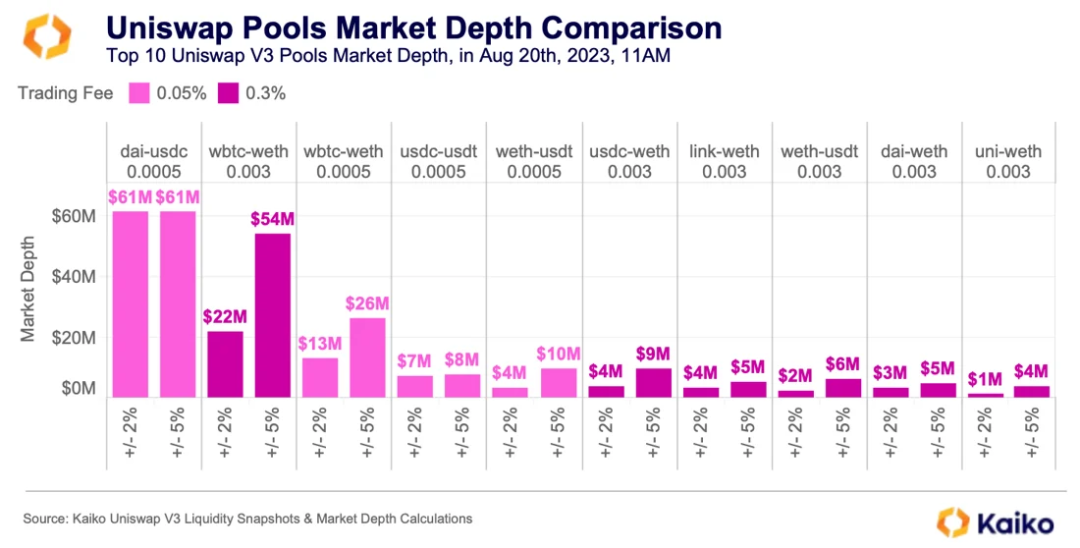Original author: Anastasia Melachrinos
Original compilation: Wu Shuo Blockchain
Market depth is a common measure of liquidity, usually calculated from order books for cryptocurrency pairs on centralized exchanges (CEXs). It provides buy and sell quantities at various distances from the mid-price, ranging from 0.1% to 10%.

This chart shows cumulative ETH-USDT buy and sell volume at various tiers across the top ten centralized exchanges. Each exchanges order book at each point in time has its own liquidity characteristics, allowing traders to choose the most appropriate platform based on their execution strategy.
In general, greater market depth leads to greater liquidity, which makes it easier to buy or sell an asset closer to the desired price. It also helps traders better estimate the slippage that may arise from larger orders. Greater market depth corresponds to lower slippage, meaning the market can accommodate larger trades without significantly changing the market price.
Uniswap V3 Market Depth
However, simply observing CEX liquidity is not enough; DEXs account for a significant portion of certain tokens’ trading volumes. For example, on August 20, Ethereum DEX accounted for 25% of USDCs trading volume and more than 80% of DAIs. But comparing the liquidity of the cryptocurrency market is quite complicated due to the different price discovery mechanisms between DEXs and CEXs.
Most DEXs do not use order books, but automated market makers (AMMs). AMMs determine asset prices by evaluating the volume of each asset in various liquidity pools at different price levels. These pools source tokens from liquidity providers (LPs), allowing traders to trade these assets directly. Although most AMM-based DEXs do not use order books, some liquidity pools (such as Uniswap V3), which specifically rely on what we call centralized products AMM, can be modeled as order books, because LP will be sold at certain prices. Tokens are stored in the interval. We can see an example in the wETH-APE 0.3% fee pool below.
To ensure that all cryptocurrency markets have accessible and comparable liquidity data, Kaiko provides users with all the data and tools they need to compare market depth between CEX and DEX.
A closer look at Uniswap V3 market depth: we calculate it in terms of alpha level (as a percentage of the block’s current price) for a specific Uniswap V3 pool and block. Using Kaikos Uniswap V3 liquidity snapshot data, we track liquidity, including the number of tokens available to liquidity providers at different price ranges that have been initialized. Then apply the Uniswap V3 equation to find how many tokens can be swapped before the price changes by 1 + α. α ranges from -/+ 0.1% to + 20% compared to the market price.
Comparing Uniswap V3 and CEX market depth
With that out of the way, let’s take a look at the market depth of one of the cryptocurrency’s most liquid trading pairs, (w)ETH-USDT on Binance and Uniswap V3.

Uniswap V3’s wETH-USDT 0.3% fee pool is less liquid than Binance at most price levels, with Binance having more than four times the liquidity of Uniswap at some price levels. However, Uniswap does have more liquidity at certain price levels further away from the mid-price. Its worth noting that this is just one of Uniswap V3s wETH-USDT pools, there are two other pools with different fee levels; if you combine the liquidity of these pools, they have slightly less liquidity than Binance around the mid-price , and the liquidity is higher at places farther from the middle price.
Overall, Uniswap V3’s liquidity distribution is surprisingly symmetrical, suggesting that liquidity is spread widely enough to effectively capture the majority of price movements.
In-depth breakdown of the exchange market
Although Uniswap V3 lost to Binance in the liquidity competition for the (w)ETH-USDT pair, it defeated all major CEXs in the (w)ETH-(w)BTC market. For market prices within the 0% and 6% range, the pairs 0.3% and 0.05% fee pools provide 6x and 3x liquidity respectively.

These findings are not surprising given the popularity of wETH and wBTC as underlying and quoted assets on Uniswap. These markets provide efficient paths for transactions; for example, exchanging wBTC for a niche coin is likely to go through this pair. Therefore, it makes sense for liquidity to be concentrated here.
In total, there are over 13,000 liquidity pools on Uniswap V3. in:
● Approximately 1,500 pools use wETH as the base or quoted asset, accounting for approximately 11% of the total number of pools.
● More than 500 pools include USDC, accounting for approximately 4.50% of the total.
● About 100 pools include wBTC, accounting for about 0.75% of the total number of pools.
Surprisingly, for a small token like CRV, Uniswap has lower liquidity compared to the top 5 most liquid CEXs offering CRV-(w)ETH markets.
Given the recent challenges CRV tokens have faced, liquidity in these markets is expected to be limited. In March 2023, most CRV transactions occurred on decentralized exchanges, especially during times of stress. With CRV tokens being used by Curves founders to collateralize loans on platforms like Aave, CRV holders feel uncertain. Since then, vulnerabilities in certain Curve pools have fueled uncertainty and reduced incentives for users to provide liquidity, potentially absorbing unwanted liquidity.
The most liquid Uniswap V3 pool
Looking at Uniswap V3 liquidity from a broader perspective, we can see that four of the top five most liquid Uniswap V3 pools have trading fees of 0.05%, which is the second-lowest option on Uniswap. It appears that liquidity providers (LPs) have reached an equilibrium, finding that 0.05% provides the best balance between trading volume and fees.

Compared to CEX, Uniswap V3 provides traders with competitive markets; these markets are particularly attractive to arbitrageurs due to ample liquidity at different price levels, although transaction costs may vary. This CEX/DEX normalized market depth dataset not only helps us understand the impact of recent market events on liquidity, but also reveals the role of market microstructure in shaping liquidity dynamics.










